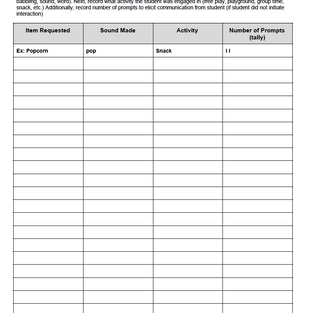5 Reasons for Detailed Classroom Procedures
- Autism Specially Designed

- Sep 21, 2018
- 9 min read
Classroom procedures are not a novel idea or practice in education. It is something we hear in every staff meeting, at every PD, and all over our schools. However, even with all of the information and research behind classroom procedures they are all too often they are overlooked. And honestly, sometimes I think as veteran educators (and newbies) we think some practices and procedures are common sense but then we find ourselves frustrated that not everyone is doing it the way we want it done.

So why do we need another blog post about classroom procedures? For one, because it something I have found myself reminding staff and training staff to do the last 2 weeks. And then there are the reasons behind the "why" of classroom procedures. We do it for the kids. We do it to help our students. We do it to make sense of hectic and chaotic days. We do it to teach independence. We do it to teach responsibility. We do it to proactively reduce problem behavior. And if we are honest, we do it to save ourselves the headaches.

So here are my questions to you:
Do you find yourselves (or your staff) repeating the SAME instruction over, and over, and over, and over again? Do you find that your students are asking the SAME questions on repeat? Do you find yourself wasting precious time on what seems like extraneous things? Do you find your students engaging in disruptive behaviors when it's time to transition? Do you find yourself frustrated that your staff STILL won't do it right? Do you find yourself questioning whether you do in fact know what you are doing?

Don't fret! We can fix it all with procedures. So here are my top 5 reasons to have DETAILED (step by step) classroom procedures. And no not for your students, for your staff. That's right what procedures do you have set up for your staff? For yourself? How will they know what to do and when to do it? If we want our students to know what to do and we want to focus on teaching them how to be independent learners and citizens of the community we must FIRST focus on teaching our staff. First our staff needs to know what to do. And then we teach our staff how to be independent in running programs and protocols.
Before I give away my reasons, I'm going to share a short story. My second year teaching, my first year in a new state and new classroom, I taught in a most restrictive placement- my classroom was the students last chance. For a lot it seemed like I got the "worst of the worst" but those were my babies. And by golly I would fight for those babies... and still would today. No one had yet found the key to unlocking their potential. No it wasn't the fault of the child, and no it wasn't the fault of the staff, but somewhere along the line the key was lost. But since I am controlling and competitive, I wouldn't settle. And I wouldn't let me students settle. We WOULD find a key, the key, THEIR key. And they would be successful in their own right! I tell you that to tell you this, it took a few months, and a few hard months at that, to figure out what my key would be to having a successful classroom. For me to be successful so that I could successfully teach my students I needed procedures (and schedules, never forget schedules😉). I was blessed with 3 paraprofessionals, countless related service providers, countless school staff, and myself all working with my babies. And as amazing as that is, it is scary, and difficult to figure out. It is difficult getting adults all on the same page, you know I'm right. I had amazing paraprofessionals but I found that they were running the room like the teacher before me (because they had been with her for so long) but it was because I hadn't taught them how I wanted my classroom. The vision and goals I had for my classroom were locked up in my head. But after trials and tribulations, I figured it out (well my best friend and co-teacher told me what to do). And from then I have never looked back. My paras thought I was INSANE when I first handed them the 10 page procedures I had made for our classroom. And even crazier when I continued to give them updated procedures every other week, or every week if necessary. BUT when I left that classroom to move back to my home state. They missed me. They missed my color coded staff schedules. And they missed my crazy procedure lists. I still remember Cathy calling me a few days after school starting begging me for a schedule and procedures. She said "I don't know what I'm supposed to do anymore, I don't know where I am supposed to be during the day, I don't know who I am supposed to be working with, and I don't know what she [the teacher] wants from me. So let that sink in for a second. If a grown-up and professional don't know what to do.... how will our students? How can we expect our students to just know without teaching them? So there is my semi-short story of why training staff in your classroom procedures are so important. And why you need classroom procedures to start with.

5 Reasons for Detailed Classroom Procedures

1. Time:
A teacher's most desired thing, time. Every teacher needs more time. It is one thing we never feel like we have enough of. But think of all the time that is wasted repeating yourself, or finding the paper you wanted, or telling your staff what they need to be doing and how they need to be doing. Something I hear all too often is "I don't have time to train them".... well make time. Bring them coffee and breakfast and ask them to come in a few minutes before school. Bring them cookies and ask them to stay a few extra minutes late. In my experience if your staff know you are trying to help make their lives easier they are willing to donate 30 minutes of their day to learn. Take the time BEFORE something happens, BEFORE the chaos to save time in the long run.

2. Energy: At the end of the day I'm drained. I also know that I'm not the only one. I'm drained and I have procedures in place. I can't even imagine how exhausted teachers without a plan feel. Having procedures in place for your staff reducing the amount of mental and physical energy you are exhausting each day to explain things to staff day by day. For example: my staff knew what was expected of them each day. Mrs. M would come in when the students came to her table for reading work she would get out the green folder and pull out the book and activity with the student's name on it. I didn't have to waste energy to tell her which book little Billy was reading today. I didn't have to explain that after she read the book he had to complete some activity. I didn't have to tell her because it was taught early in the year. She knew the procedures for what she was doing, when she was doing it, and who she was doing it with. And then my energy and my staff's energy could be focused on what is most important, our students.

3. Independence: We preach teaching independence to our students but how often do we forget that staff want it too. We are all adults, we don't want to be told what to do all day. Because I know I don't. I want to do what I know I should do and I want to be left alone while I do it. What teacher wants the principal standing in their room telling them every 5 minute what is next or how to do something? NONE. The answer is, please don't let my principal come in because then I lose focus and when I lose focus on my students I lose my students. They get distracted and find more interesting things to do because I am spending my time talking to adults instead of engaging my students. So if we have procedures and plans ready and taught then they can be independent in doing their job. And our staff can feel a sense of responsibility and autonomy, as well. Because at the end of the day we are all humans and we want to do our job and do it well. And we want to be proud of what we accomplished each and every day.

4. Behavior Reduction (student AND staff): If we have a plan and by plan I mean step-by-step how to complete tasks there is no time for our staff (or our students) to figure out what they would do. But what they would do may not be what we would do. And then adults are confused, kids are confused and then BOOM behaviors! Reduce confusion, reduce behaviors!

5. Students:
Of course, of the reasons we do this is for our students. We do it to make our lives easier but we do it to better the lives of our students. If our day goes well, their day goes well. If we are happy, they are happy. We want to teach them to the best of our ability then our staff need to know what they are doing.
Bonus: 5 of My Go-To Staff Procedures
1. Schedule Procedures:
Each student has a picture icon schedule with first/then pouch or written schedule
When the timer goes off to end an activity it is time to transition and check schedules
Prompt students, “check your schedule” (do not say, “it is time for _____” or “go to____”) -- we are teaching them to check their own schedules
The student walks to the schedule area and places the completed activity in "all done" , the student then moves "next" to "first" and then takes the top icon off the wall schedule (the student should be the one to move the pieces of their schedule- you can prompt as necessary )
When it is time to check the schedule, prompt the student take his/her first/then pouch to their schedule. They take the top icon off the wall schedule and place on their pouch.
When activity is finished, prompt the student to move the completed activity icon to “all done”- then prompt to check schedule

2. Data Procedures:
Data must be taken on each student's behavior all day: aggression, self injurious behaviors, property destruction, and unwanted behaviors (see sheet).
This includes all activities throughout the student's daily schedule (ex: lunch, PE, electives, snack)
There are specific data sheets for student's participating in the inclusion classrooms (check student's binder)
IEP data will be taken on a schedule (see sheet) - IEP data may include expressive language, requesting, academics, behavior, toileting, functional skills, PRT, etc.
Some have social goals-this will be taken during general education inclusion or during lunch and recess, and will be through interval recording (I will train you on this before you start)
Data sheets will be located in different areas throughout the classroom (ex: PRT data sheets will be found near the snack table, by circle time, in the play area, in the sensory area; Functional Routine data sheets will be found near the classroom door, cubbies, bathroom, sink, etc.)
3. Calm Down Procedures:
Calm down is not a punishment, teaching self-regulation of emotions and behaviors is essential for our students with ASD and ED
If a student starts to become agitated or upset prompt them to take a break in the calm down area- calmly walk student to calm down - use visuals
When in calm down, set timer for 3 minutes. When timer goes off ask student if they are ready to practice relax.
If the student says “no” reset timer for 3 minutes- continue until student is calm and ready
When ready, student is calm and responding- prompt through relax sequence- teacher reads and student completes steps of sequence
When finished with relax sequence, student goes back to activity they came from

4. Choice Time Procedures:
Each student has an individualized token system- students can earn choice time if they earn all tokens for following classroom/individual rules/expectations
Student chooses choice time activity using their individual choice board
Set timer for 5 minutes
When timer goes off, turn off the timer (or have student turn off timer)- make sure all students heard timer (you can say “that is the timer” or “what does that sound mean?”)
Tell the student “choice time is all done, check schedule” - assist as needed
If student has difficulty, remind student they can earn choice time again.

5. Requesting Procedures:
All students will request supplies they need throughout the day. That includes supplies needed at the art table, food and drink during snack, group work (set up the environment to elicit language)
Students will request based on their abilities and goals (full sentences, approximations, sign, PECS, voice output)
If student does not independently request needed item, prompt "What do you need?" or "what do you want?" depending on situation
Prompt using least to most prompting as needed
For students with higher level requesting skills, prompt to use a variety of carrier phrases (ex: I want..., Can I..., Give me..., Will you..., I need..., Can you...)
Receiving the desired item is the reinforcer for requesting skills!

Today's challenge: Create 5 new procedures in your classroom to get staff all on the same page!

Happy Friday ya'll!
~Kaylan~
_edited.png)










Comentarios